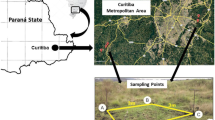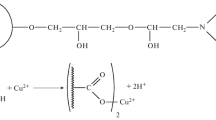Abstract
Organic acids including humic, fulvic, aliphatic and aromatic acids comprise part of the dissolved organic carbon (DOC) present in soil solution. They act as ligands for trace metals and are effective detoxifiers of monomeric aluminium (Al). Solid phase extraction (SPE) techniques permit fractionation of the DOC into organic classes but yield no information on the pre-existing Al/organic acid complexes. Aliphatic and aromatic acids may be separated and determined by High Performance Liquid Chromatography (HPLC); however, the conditions used dissociate the organic acid Al complexes. Humic and fulvic acids are of a variable and ill-defined nature and only limited information exists regarding their binding of Al. This paper reports on fractionation studies of soil solutions, using both SPE and molecular weight cut-off filters, to characterise the DOC components and on the subsequent development of a size exclusion chromatography (SEC) system for the separation of organically complexed Al into different species using a low ionic strength mobile phase at pH 4.2. Model complexes of Al and Cu citrate were used to evaluate chromatographic performance of a Fractogel TSK HW-40(S) column (1×30 cm). For soil solution samples, the column eluate, after passing through a UV detector, was directly coupled to an Inductively Coupled Plasma Atomic Emission Spectrometer (ICPAES) for on-line multi-element detection to characterise DOC and trace metal distribution.
Fractionation studies revealed that polysaccharides constituted the major proportion of the DOC which passed the 10000 dalton molecular weight cut-off filter. Analysis of soil solutions from an organically amended soil by the SEC-ICPAES system showed that Al, Fe and Mn eluted as multiple peaks prior to the bed volume, indicating their presence as complexes with organic ligands.
Similar content being viewed by others
References
Bartlett R J and Riego D C 1972 Effect of chelation on the toxicity of aluminum. Plant and Soil 37, 419–423.
Bertsch P M and Anderson M A 1989 Speciation of aluminum in aqueous solutions using ion chromatography. Anal. Chem. 61, 535–539.
Blondeau R 1985 Separation of low molecular weight humic acids with Sephadex G25. Plant and Soil 87, 441–444.
Dawson H J, Hrutfiord B F, Zasoski R J and Ugolini F C 1981 The molecular weight and origin of yellow organic acids. Soil Sci. 132, 191–199.
Gibson J A E and Willett I R 1991 The application of fluorescence detection to the determination and speciation of aluminium in soil solutions by ion chromatography. Commun. Soil Sci. Plant Anal. 22, 1303–1313.
Gillman G P 1976 A centrifuge method for obtaining soil solution. CSIRO Aust. Div. Soils Div. Rep. No. 16.
Hue N V, Craddock G R and Adams F 1986 Effect of organic acids on aluminum toxicity in subsoils. Soil Sci. Soc. Am. J. 50, 28–34.
Kerven G L, Asher C J, Edwards D G and Ostatek-Boczynski Z 1991 Sterile solution culture techniques for aluminum toxicity studies involving organic acids. J. Plant Nutr. 14, 975–985.
Kerven G L, Edwards D G, Asher C J, Hallman P S and Kokot S 1989 Aluminium determination in soil solution. II. Short term colorimetric procedures for the measurement of inorganic monomeric aluminium in the presence of organic acid ligands. Aust. J. Soil Res. 27, 91–102.
Kerven G L, Larsen P L, Bell L C and Edwards D G 1995 Quantitative 27Al NMR spectroscopic studies of Al (III) complexes with organic acid ligands and their comparison with GEOCHEM predicted values. Plant and Soil 171, 35–39.
McColl J G and Pohlman A A 1986 Soluble organic acids and their chelating influence on Al and other metal dissolution from forest soils. Water Air Soil Pollut. 31, 917–927.
Pohlman A A and McColl J G 1988 Soluble organics from forest litter and their role in metal dissolution. Soil Sci. Soc. Am. J. 52, 265–271.
Stevenson F J and Fitch A 1986 Chemistry of complexation of metal ions with soil solution organics. In Interactions of Soil Minerals with Natural Organics and Microbes. Eds. W H Huang and M Schnitzer. pp 29–58. Soil Science Society of America Special Publication No. 17, 1986, Madison, WI, USA.
Sweet M S and Perdue E M 1982 Concentration and speciation of dissolved sugars in river water. Environ. Sci. Technol. 16, 692–698.
Tam S C and McColl J G 1990 Aluminum and calcium binding affinities of some organic ligands in acidic conditions. J. Environ. Qual. 19, 514–520.
Whitten M G, Ritchie G S P and Willett I R 1992 Forms of soluble aluminium in acidic topsoils estimated by ion chromatography and 8-hydroxyquinoline and their correlation with growth of subterranean clover. J. Soil Sci. 43, 283–293.
Willett I R 1989 Direct determination of aluminum and its cationic fluoro-complexes by ion chromatography. Soil Sci. Soc. Am. J. 53, 1385–1391.
Author information
Authors and Affiliations
Rights and permissions
About this article
Cite this article
Kerven, G.L., Ostatek-Boczynski, Z., Edwards, D.G. et al. Chromatographic techniques for the separation of Al and associated organic ligands present in soil solution. Plant Soil 171, 29–34 (1995). https://doi.org/10.1007/BF00009560
Issue Date:
DOI: https://doi.org/10.1007/BF00009560




